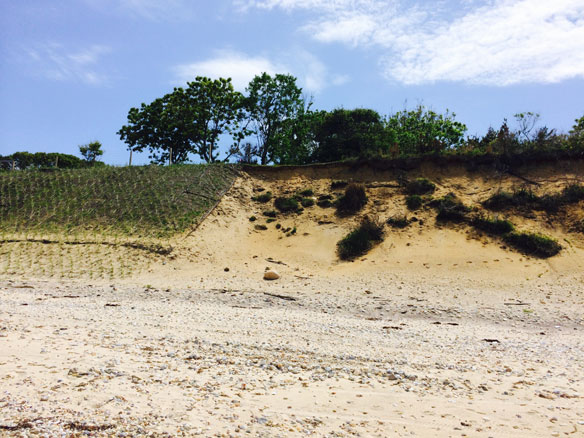Photograph: Coastal restoration, New York. Photograph © SAF — Coastal Care
Research over the last decade points toward the pursuit of living shorelines for coastal landowners seeking erosion control.But, with regulatory lag and miles of shoreline lost each year to harsh structures, it’s not always easy…
Read Full Article; PortCity (05-12-2018)
Rethinking Living Shorelines, By Orrin H. Pilkey, Rob Young, Norma Longo, and Andy Coburn;Program for the Study of Developed Shorelines / Western Carolina University, March 1, 2012, Nicholas School of the Environment, Duke University
In response to the detrimental environmental impacts caused by traditional erosion control structures, environmental groups, state and federal resource management agencies, now advocate an approach known as “Living Shorelines”that embraces the use of natural habitat elements such as indigenous vegetation, to stabilize and protect eroding shorelines.
“Living Shorelines” Will Get Fast Track to Combat Sea Level Rise; Scientific American (07-06-2016)
As sea levels rise along U.S. coasts, it may soon get easier for people and local governments to obtain federal permits to build what are known as “living shorelines,” natural or nature-based structures designed to protect communities and infrastructure from extreme storms and flooding even as they protect habitat.
NOAA Study Finds Marshes, Reefs, Beaches Can Enhance Coastal Resilience, NOAA (04-29-2015)
NOAA study finds ‘living shorelines’ can lessen climate change’s effects, NOAA (12-22-2015)
Living Shorelines: Better Than Bulkheads, Coastal Review Online (02-08-2016)
More than 14,000 miles – 14 percent of continental U.S. coastline — has been armored with hardened structures. Hardened structures cause elevated rates of erosion on the shoreward side of the structure…
“Seawalls Kill Beaches,” Open Letters by Warner Chabot And Rob Young, (10-03-2014)
“Engineering away our natural defenses: An analysis of shoreline hardening in the US,” A Study by By Rachel K. Pittman, ResearchGate (08-08-2015)
Rapid coastal population growth and development are primary drivers of marine habitat degradation. Although shoreline hardening, a byproduct of development, can accelerate erosion and loss of beaches and tidal wetlands, it is a common practice globally. 22,842 km of continental U.S. shoreline, 14% of the total, has been hardened…
“North Carolina: The Beaches Are Moving,” A Video featuring Orrin Pilkey, PhD
World famous coastal geologist Orrin H. Pilkey takes us to the beach and explains why erosion has become a problem…









